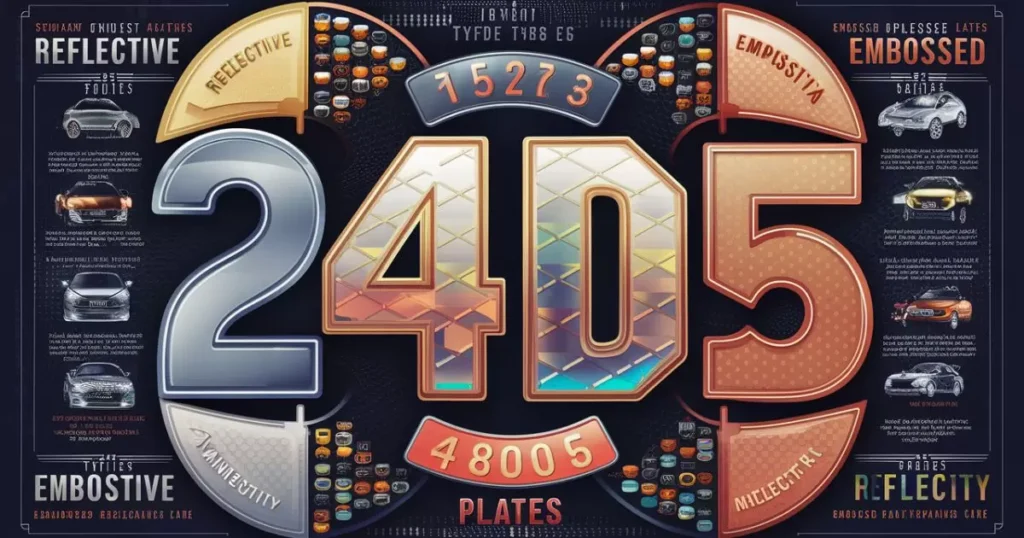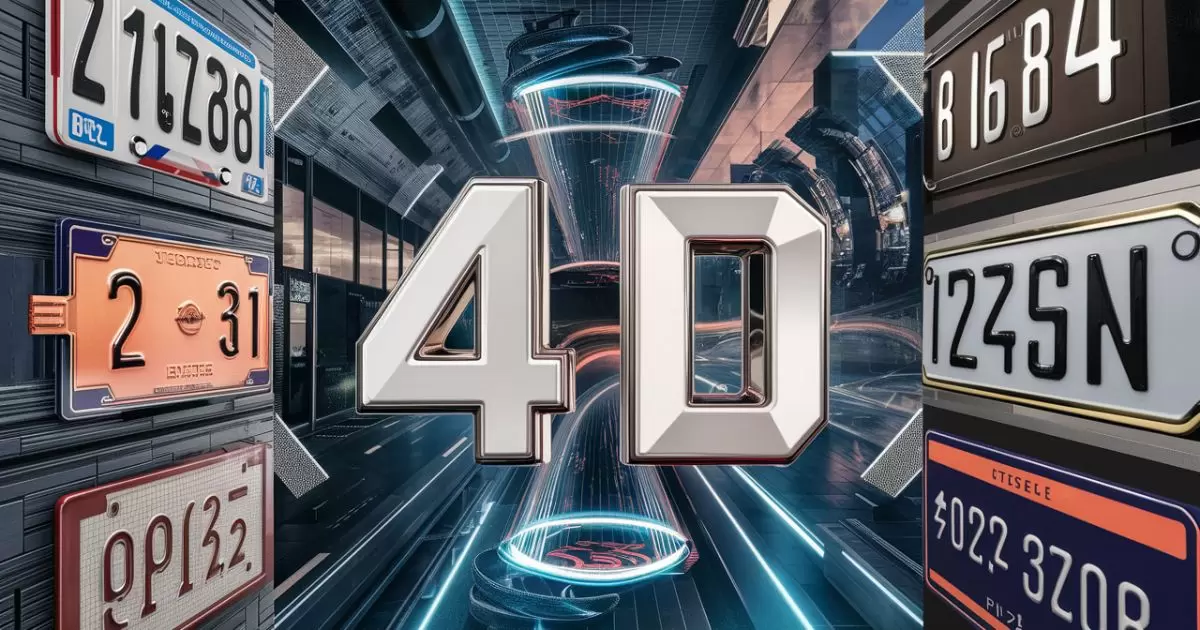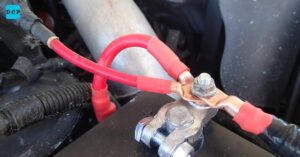Introduction
“4D number plates feature a distinctive 3D design with raised acrylic characters, setting them apart from standard printed or gel plates.“
Number plates have evolved significantly over the years, with 4D number plates becoming one of the latest trends. As the demand for personalization and unique vehicle aesthetics increases, many drivers are opting for 4D plates over traditional styles. But what makes these plates stand out?
In this article, we will explore the key differences between 4D number plates and other popular styles, including standard printed plates, gel plates, and 4D gel plates.
We’ll also discuss factors like durability, legality, installation, customization options, and maintenance, giving you a comprehensive understanding of how 4D number plates compare to other styles.
The Key Differences Between 4D and Standard Printed Number Plates

4D number plates differ significantly from standard printed number plates in both appearance and construction. Standard printed plates are flat and typically feature a basic printed design, which is functional but lacks the visual depth that many drivers seek.
On the other hand, 4D plates are made by layering acrylic characters onto the plate, creating a raised, three-dimensional effect. This 3D appearance gives 4D plates a unique and modern look that many find more attractive.
Another key difference lies in the materials used. Standard printed plates are often made from a single piece of plastic, with the letters and numbers printed directly onto the surface. In contrast, 4D plates are made using multiple layers of high-quality acrylic, which not only enhances their visual appeal but also increases their durability.
The additional layers make 4D plates more resistant to wear and tear, ensuring they maintain their stylish appearance for longer.
The Aesthetic Differences Between 4D and Gel Number Plates
Aesthetics play a major role in the popularity of 4D number plates and gel number plates. While both options offer a premium look, they do so in different ways. Gel plates have a glossy, domed finish, achieved by applying a layer of resin over the characters.
This gives the letters and numbers a smooth, bubble-like appearance that catches the light beautifully, making them stand out on the road.
In contrast, 4D plates feature sharp, defined edges, thanks to the laser-cut acrylic characters. This creates a more angular, bold look compared to the softer, rounded appearance of gel plates.
The raised letters on 4D plates also contribute to their unique aesthetic, offering a sense of depth that gel plates cannot match. For those seeking a modern, sleek look, 4D plates are often the preferred choice.
What Is the Difference Between 4D Plates and 4D Gel Number Plates?
When comparing 4D plates to 4D gel number plates, the primary difference lies in the finish. Standard 4D plates consist of laser-cut acrylic characters that are layered onto the plate, creating a sharp and defined 3D effect.
These plates have a matte or glossy finish, depending on the material used, and are known for their bold and modern look.
4D gel number plates take this design a step further by adding a layer of resin to the acrylic characters, giving them the same domed, glossy finish seen in gel plates.
This combination of sharp, raised characters with a smooth, shiny surface offers a unique blend of both 4D and gel plate aesthetics. The result is a plate that not only stands out due to its three-dimensional design but also catches the light in a way that enhances its visual impact.
Comparing the Price: 4D Plates Vs. Other Number Plates
Price is often a deciding factor when choosing between 4D plates and other styles. Standard printed plates are the most affordable option, as they are mass-produced and made from simple materials. Their cost is relatively low, making them an attractive choice for those on a budget.
Gel plates and 4D plates are generally more expensive due to the materials and manufacturing process involved. Gel plates, with their resin-coated finish, tend to be priced higher than standard plates but lower than 4D plates. 4D plates are the most expensive option among these styles, as the layering of acrylic and the precision required in their production increases the cost.
Despite the higher price, many find that the visual appeal and durability of 4D plates justify the investment. They offer a premium look that can enhance the overall appearance of a vehicle, making them a popular choice for those who want to stand out on the road.
The Popularity of 4D Number Plates Compared to Other Styles
4D number plates have gained popularity rapidly, surpassing other styles in recent years. Their modern and bold appearance appeals to a wide range of drivers, from car enthusiasts to those simply looking to personalize their vehicle. The unique three-dimensional effect sets them apart from standard printed and gel plates, making them a preferred choice for those who want their vehicle to stand out.
While standard printed plates remain common due to their affordability and simplicity, they lack the visual impact that 4D plates provide. Gel plates continue to be popular for their glossy finish and sleek design, but the sharper, more defined look of 4D plates has made them a strong contender in the market. As more drivers seek customization options that reflect their personal style, the demand for 4D plates is expected to continue growing.
Durability: How 4D Number Plates Stand Up Against Other Styles

Durability is a crucial factor to consider when choosing number plates. 4D plates are known for their robustness, thanks to the multiple layers of acrylic used in their construction.
This makes them more resistant to scratches, fading, and other forms of wear and tear compared to standard printed plates, which are often made from a single layer of plastic.
Gel plates also offer good durability, particularly due to the resin coating that protects the characters from damage. However, the sharp edges and solid build of 4D plates give them an edge in terms of long-term resilience.
For those who want a number plate that maintains its appearance over time, 4D plates are an excellent choice.
Legality: Are 4D Number Plates Compliant Compared to Other Plates?
When it comes to legality, it’s essential to ensure that your number plates comply with the regulations set by the authorities. Standard printed plates are widely accepted, provided they meet the basic requirements for font, spacing, and reflectivity. Gel plates and 4D plates are also legal, but they must adhere to the same standards.
The primary concern with 4D plates is that their raised characters can sometimes exceed the allowed height, making them non-compliant. It’s crucial to purchase 4D plates from reputable suppliers who ensure that their products meet all legal requirements.
As long as the plates are manufactured within the legal specifications, 4D plates are just as compliant as other styles.
Driver’s Licenses in an Autonomous World: Necessary or Obsolete?
Ease of Installation: 4D Number Plates Versus Traditional Options
4D plates are relatively easy to install, much like standard printed plates and gel plates. The process involves securing the plate to the vehicle using screws or adhesive pads. However, due to the thickness and weight of 4D plates, it’s important to ensure that they are securely fastened to prevent them from coming loose.
The raised characters on 4D plates can make them slightly more challenging to handle during installation, especially when aligning them correctly.
However, with careful attention and proper tools, installing 4D plates can be done without much difficulty. For those unfamiliar with the process, professional installation is always an option to ensure a perfect fit.
Customization Options: 4D Plates Compared to Other Number Plate Styles
One of the key attractions of 4D plates is the wide range of customization options they offer. Unlike standard printed plates, which are typically limited to basic fonts and designs, 4D plates can be tailored to reflect personal preferences. This includes choosing different colors, fonts, and even adding borders or special designs.
Gel plates also offer customization options, particularly in terms of the color and finish of the resin. However, 4D plates provide a more distinctive look with their raised, three-dimensional characters. This allows for a higher level of personalization, making 4D plates an excellent choice for those who want a truly unique number plate.
Maintenance and Care: How 4D Plates Compare to Other Number Plate Types

Maintaining 4D plates is relatively straightforward, but they do require a bit more care than standard printed plates. The raised acrylic characters can accumulate dirt and grime, which may require regular cleaning to keep them looking their best. A gentle wash with soapy water and a soft cloth is usually sufficient to maintain their appearance.
Gel plates also need regular cleaning to prevent dirt buildup on the resin surface. However, the smooth finish of gel plates makes them easier to clean compared to the intricate edges of 4D plates. While both styles require some maintenance, 4D plates may need a bit more attention to keep them in top condition.
Answer to Key Questions
- Are 4D number plates legal?
Yes, 4D number plates are legal as long as they meet the regulatory requirements for size, font, spacing, and reflectivity. It’s important to buy from a reputable supplier to ensure compliance.
- Do 4D plates cost more than standard plates?
Yes, 4D plates are generally more expensive than standard printed plates due to the materials and manufacturing process involved.
- How do I clean and maintain 4D plates?
4D plates can be cleaned using soapy water and a soft cloth. Regular cleaning is recommended to prevent dirt buildup around the raised characters.
- Can I install 4D plates myself?
Yes, 4D plates can be installed at home using screws or adhesive pads. However, due to their thickness, ensure they are securely fastened.
- What’s the difference between 4D and 4D gel plates?
The difference lies in the finish. 4D plates have sharp, defined characters, while 4D gel plates feature a resin coating that gives them a glossy, domed finish.
- Are 4D plates more durable than other styles?
4D plates are highly durable due to their acrylic construction, making them more resistant to wear and tear compared to standard printed plates.
Conclusion
4D number plates offer a unique and modern look that sets them apart from other styles. With their raised, three-dimensional characters, they provide a bold aesthetic that appeals to many drivers.
While they are more expensive than standard and gel plates, their durability and customization options make them a worthwhile investment.
As the popularity of 4D plates continues to grow, it’s essential to consider factors like legality, installation, and maintenance to ensure you get the most out of your purchase.
Whether you choose 4D plates for their style or durability, they are a standout choice that can enhance the appearance of any vehicle.

Hi! I’m the admin of Drive Cars Pedia, where I share my passion for cars with you. From reviews to tips, I provide valuable info to help you make informed decisions. Enjoy your visit!








